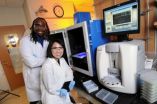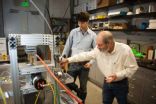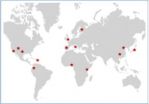(Press-News.org) Using advanced microscopes equipped with tissue-penetrating laser light, cancer imaging experts at Johns Hopkins have developed a promising, new way to accurately analyze the distinctive patterns of ultra-thin collagen fibers in breast tumor tissue samples and to help tell if the cancer has spread.
The Johns Hopkins researchers say their crisscrossing optical images, made by shining a laser back and forth across a biopsied tissue sample a few millionths of a meter thick, can potentially be used with other tests to more accurately determine the need for lymph node biopsy and removal in women at risk of metastatic breast cancer.
In what is believed to be the first study to measure minute changes in tumor connective tissue fibers, researchers found that eight women whose cancers had spread beyond the breast through the body's lymphatic system had about 10 percent more densely packed and radially spread-out collagenous structural proteins than six women whose cancers had not yet spread. Collagen fibers in the non-metastasized tumors, also obtained during breast biopsy, were more diffuse and arranged in a transverse or horizontal pattern. All 14 women in the study had aggressive, malignant breast cancer.
In the new report, to be published in the Journal of Biomedical Optics online Nov. 1, researchers say that if these "proof of principle" findings hold up in testing now under way in hundreds more women with or without metastatic breast cancer, then their new optical imaging tool could simplify testing for spreading disease and help people avoid unnecessary lymph node surgery.
"Our new diagnostic technique has the potential to help reassure thousands of breast cancer patients that their cancers have not spread to other organs, and could help them avoid the risks and pain currently involved in direct inspections of lymph nodes for the presence of cancerous cells," says study senior investigator Kristine Glunde, Ph.D.
Women with denser tumor fiber patterns would likely stand a greater chance of needing lymph node biopsy and removal and inspection of such tissue for malignant cells, says Glunde, an associate professor at the Johns Hopkins University School of Medicine Russell H. Morgan Department of Radiology and the Sidney Kimmel Comprehensive Cancer Center.
Glunde says complications from lymph node biopsy and more invasive dissection include risk of infection, pain, severe swelling and leakage of lymph fluid around the armpit, as well as stiffening in the arm, which can be permanent. An estimated 230,000 Americans were diagnosed in 2011 with invasive breast cancer, while another 57,000 were found to have noninvasive, or in-situ breast cancer.
Cancer imaging experts have known for more than a decade that the fibrous connective tissue located between cancer cells changes and bunches together as tumors grow and disease spreads, says study co-investigator Zaver Bhujwalla, Ph.D., a professor at Johns Hopkins and its Kimmel Cancer Center.
"Until now, however, we had no proof in principle that such minute and progressive changes outside cancer cells, in the tumor micro-environment or extracellular matrix, could be measured and potentially used to better guide our staging and treatment decisions," says Bhujwalla, who also serves as director of the Johns Hopkins In Vivo Cellular and Molecular Imaging Center (ICMIC), where the latest imaging study was performed.
It was also at ICMIC in 2010, supported with funds from the U.S. National Cancer Institute (NCI), that Glunde, Bhujwalla and fellow study co-investigator Meiyappan Solaiyappan, B.S., developed the specialized computer software used to analyze the microscopic spaces between tumor collagen fibers and calculate their density.
The tissue fiber images were obtained using an optical imaging technique called second harmonic generation microscopy, in which a long-wavelength laser light is deflected off the collagen fibers for a few seconds, allowing for several planes and fields of view to be captured. The longer infrared wavelength, at 880 micrometers, was chosen because it can penetrate the tissue beyond the colorful light waves visible to the human eye, but does not damage and heat up the cancer cells, as a slightly longer infrared wavelength would. Glunde says the many fields of view were randomly taken throughout the tissue sample, providing a "realistic representation of each breast cancer sample." Breast biopsy samples came from tissue research collections in Maryland.
###
The new study was performed entirely at Johns Hopkins, with funding support from the NCI, part of the National Institutes of Health.
In addition to Glunde, Bhujwalla and Solaiyappan, other Johns Hopkins researchers involved in this imaging study were Samata Kakkad, M.S.; Saraswati Sukumar, Ph.D.; Lisa Jacobs, M.D.; and Pedram Argani, M.D. Another study investigator was Dieter Leibfritz, Ph.D., at the University of Bremen, in Germany.
For additional information, go to:
http://icmic.rad.jhmi.edu/ICMICorganization/ProgDirZB.html
http://projectreporter.nih.gov/reporter_searchresults.cfm
Laser-light testing of breast tumor fiber patterns helps show whose cancer is spreading
New diagnostic tool could lower numbers of unnecessary lymph node surgeries
2012-11-01
ELSE PRESS RELEASES FROM THIS DATE:
George Mason University researchers target breast cancer in 3 trials
2012-11-01
Fairfax, Va. -- A malarial drug is showing promise in stopping breast cancer before it starts, Mason researchers are discovering during a clinical trial.
"The bold long-term goal is a short-term oral treatment that prevents breast cancer by killing the precursor cells that initiate breast cancer," says Lance Liotta, co-director of Mason's Center for Applied Proteomics and Molecular Medicine (CAPMM). "And it's looking hopeful."
The PINC trial (Preventing Invasive Neoplasia with Chloroquine) targets ductal carcinoma in situ, or DCIS, the most common type of pre-invasive ...
Researchers use blood testing to predict level of enzymes that facilitate disease progression
2012-11-01
Predicting how atherosclerosis, osteoporosis or cancer will progress or respond to drugs in individual patients is difficult. In a new study, researchers took another step toward that goal by developing a technique able to predict from a blood sample the amount of cathepsins—protein-degrading enzymes known to accelerate these diseases—a specific person would produce.
This patient-specific information may be helpful in developing personalized approaches to treat these tissue-destructive diseases.
"We measured significant variability in the amount of cathepsins produced ...
Mice with 'humanized' livers improve early drug testing, Stanford scientists show
2012-11-01
STANFORD, Calif. — Stanford University School of Medicine scientists have used bioengineered mice with livers composed largely of human cells to characterize a drug about to enter early-stage clinical development for combating hepatitis C.
Tests using the new mouse model accurately predicted significant aspects of the drug's behavior in humans — including its interaction with another drug and the profile of its major breakdown products in the body (called metabolites) — far more accurately than would have been achieved using current methods.
The study will be published ...
Regional analysis masks substantial local variation in health care spending
2012-11-01
PITTSBURGH, Oct. 31, 2012 – Reforming Medicare payments based on large geographic regions may be too bluntly targeted to promote the best use of health care resources, a new analysis from the University of Pittsburgh Graduate School of Public Health suggests. The analysis will be published in the Nov. 1 issue of the New England Journal of Medicine.
"Much policy attention has been drawn to the large geographic variation in health care spending across regions, and for good reason – because regional variation points to inefficient use of resources," said lead author Yuting ...
Tabletop fault model reveals why some quakes result in faster shaking
2012-11-01
Berkeley — The more time it takes for an earthquake fault to heal, the faster the shake it will produce when it finally ruptures, according to a new study by engineers at the University of California, Berkeley, who conducted their work using a tabletop model of a quake fault.
"The high frequency waves of an earthquake — the kind that produces the rapid jolts — are not well understood because they are more difficult to measure and more difficult to model," said study lead author Gregory McLaskey, a former UC Berkeley Ph.D. student in civil and environmental engineering. ...
Unexpected factor contributes to melanoma risk in red-haired, fair-skinned individuals
2012-11-01
The well-established elevated risk of melanoma among people with red hair and fair skin may be caused by more than just a lack of natural protection against ultraviolet (UV) radiation. In an article receiving Advance Online Publication in Nature, Massachusetts General Hospital (MGH) Cutaneous Biology Research Center (CBRC)and Cancer Center researchers report finding that the type of skin pigment predominantly found in red-haired, fair-skinned individuals may itself contribute to the development of melanoma.
"We've known for a long time that people with red hair and ...
Pond skating insects reveal water-walking secrets
2012-11-01
This month's special issue of Physics World is devoted to animal physics, and includes science writer Stephen Ornes explanation of how pond skaters effortlessly skip across water leaving nothing but a small ripple in their wake.
As Ornes writes, our current understanding of the mechanisms adopted by the pond skater is down to the efforts of David Hu, who as a mathematics graduate from the Massachusetts Institute of Technology spent four years studying their behaviour.
Hu, along with his PhD supervisor John Bush, found that pond skaters use the middle of their three ...
Sleep duration affects hunger differently in men and women
2012-11-01
A new study suggests that increasing the amount of sleep that adults get could lead to reduced food intake, but the hormonal process differs between men and women.
"Restricting sleep in healthy, normal weight participants has limited effects on metabolic risk factors and may affect food intake regulating hormones differently in men and women," said Marie-Pierre St-Onge, PhD, FAHA, the study's principal investigator. "We were surprised by the lack of a significant effect of sleep on glucose and insulin, leptin, and sex differences in the hunger-stimulating hormone ghrelin ...
Scientific team sequences 1,092 human genomes to determine standard range of human genetic variation
2012-11-01
Completing the second phase of the 1000 Genomes Project, a multinational team of scientists reports that they have sampled a total of 1092 individuals from 14 different populations and sequenced their full genomes. The researchers described the feat as a collegial effort to equip biologists and physicians with information that can be used to understand the normal range of human genetic variants so that a patient's disease genome can be interpreted in a broader context.
A report on the research, published online in Nature on Nov. 1 represents the culmination of five years ...
1,000 Genomes Project paints detailed picture of human variation
2012-11-01
HOUSTON -- (Nov. 1, 2012) – First, there was the single human reference genome completed in 2003. Then there was the HapMap project to identify the common genetic variants occurring in human beings with the first map published in 2005. Now an international consortium has released the first phase of the 1,000 Genomes Project that profiles the rare and common genetic variations in 1,092 people drawn from 14 human populations from Europe, Africa, East Asia and the Americas.
The next phase of the project will include as many as 3,000 individuals, said Dr. Fuli Yu (www.bcm.edu/genetics/index.cfm?pmid=23673
), ...
LAST 30 PRESS RELEASES:
New UBCO research challenges traditional teen suicide prevention models
Diversity language in US medical research agency grants declined 25% since 2024
Concern over growing use of AI chatbots to stave off loneliness
Biomedical authors often call a reference “recent” — even when it is decades old, analysis shows
The Lancet: New single dose oral treatment for gonorrhoea effectively combats drug-resistant infections, trial finds
Proton therapy shows survival benefit in Phase III trial for patients with head and neck cancers
Blood test reveals prognosis after cardiac arrest
UBCO study finds microdosing can temporarily improve mood, creativity
An ECOG-ACRIN imaging study solves a long-standing gap in metastatic breast cancer research and care: accurately measuring treatment response in patients with bone metastases
Cleveland Clinic presents final results of phase 1 clinical trial of preventive breast cancer vaccine study
Nationally renowned anesthesiology physician-scientist and clinical operations leader David Mintz, MD, PhD, named Chair of the Department of Anesthesiology at the UM School of Medicine
Clean water access improves child health in Mozambique, study shows
Study implicates enzyme in neurodegenerative conditions
Tufts professor named Fellow of the National Academy of Inventors
Tiny new device could enable giant future quantum computers
Tracing a path through photosynthesis to food security
First patient in Arizona treated with new immune-cell therapy at HonorHealth Research Institute
Studies investigate how AI can aid clinicians in analyzing medical images
Researchers pitch strategies to identify potential fraudulent participants in online qualitative research
Sweeping study shows similar genetic factors underlie multiple psychiatric disorders
How extreme weather events affect agricultural trade between US states
Smallholder farms maintain strong pollinator diversity – even when far from forests
Price of a bot army revealed across hundreds of online platforms worldwide – from TikTok to Amazon
Warblers borrow color-related genes from evolutionary neighbors, study finds
Heat signaling from plants is an ancient pollinator signal
New index reveals the economics underlying the online manipulation economy
High-resolution satellite observations reveal facility-level methane emissions worldwide
Researchers discover how Ebola and Marburg disrupt the gastrointestinal tract
Feeling the heat
Eastward earthquake rupture progression along the Main Marmara Fault towards Istanbul
[Press-News.org] Laser-light testing of breast tumor fiber patterns helps show whose cancer is spreadingNew diagnostic tool could lower numbers of unnecessary lymph node surgeries


